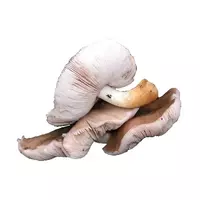Plutey of deer

Plutaeus deer refers to edible fungi belonging to the genus Plutaeus in the family Pluteaceae. Interestingly, the Russian name of this mushroom is tracing paper from Latin, but the name of the deer mushroom can also be used.
There is a fairly common interpretation according to which the name of the plutey of deer owes it to the fact that it is willingly eaten by deer or at the expense of the brown ("deer") color of the hat. In fact, the species epithet cervinus can be explained by the fact that large cells of the hymenial layer of the fungus (cystids) end in teeth.
This mushroom is characterized by an average hat diameter of 4 to 10 centimeters. In shape, it is at first wide-rimmed, after which (as it matures) it becomes convex or flat-dispersed, with a tubercle in the center. The cylindrical mushroom leg is dense and solid can be painted white or whitish gray. It is covered with longitudinal brown fibers, which acquire a lighter color towards the hat.
The white flesh of deer spit is soft and brittle. In the leg, it becomes more fibrous and rigid. For this mushroom, any certain taste is not characteristic - only a weak radish smell distinguishes the plutum of deer. When cut, the color of the pulp does not change.
The pluteus of deer is considered a saprophyte, that is, a mushroom that prefers to grow on decaying wood. It is most widespread in the temperate northern zone. Deer pluts are most often found in deciduous forests (less often conifers), as well as parks and gardens.
The spit of deer can grow both singly and in small groups. In our country, it is harvested from late spring to late October, and residents of the middle strip of the European part of Russia are used to seeing this mushroom from mid-June to late August.
In general, there are at least 140 species of mushrooms in the genus of plutes, some of which are quite difficult to distinguish between themselves. For example, black-edged spit is a rarer species characterized by a blackish hat and dark-colored edges of plates. Pouzard's plume can be recognized by the presence of buckles on hyphae, but this is only discernible under a microscope. Collibia broadleaf, also belonging to this genus, belongs to inedible or conditionally edible mushrooms.
Meanwhile, the plutey of deer belongs to edible mushrooms of poor quality, that is, to the fourth category. The food qualities of this mushroom are quite mediocre: due to the watery flesh, uncertain taste and not particularly unpleasant smell, which can persist even after boiling, some mushroom pickers completely avoid it, while others always put it in karzina.
deer plutea 19 kCal
Energy value of deer plutum (Ratio of proteins, fats, carbohydrates - ju):
Proteins: 1.7 g (~ 7 kCal)
Fats: 0.7 g (~ 6 kCal)
Carbohydrates: 1.5 g (~ 6 kCal)
Energy ratio (b | y): 36% | 33% | 32%
 Español
Español Français
Français Português
Português Русский
Русский 简体中文
简体中文 繁體中文
繁體中文 日本語
日本語 한국어
한국어 العربية
العربية Türkçe
Türkçe Қазақ
Қазақ Deutsch
Deutsch Italiano
Italiano Українська
Українська
